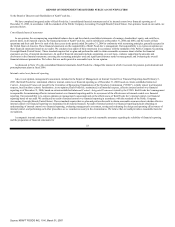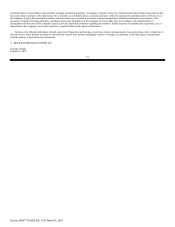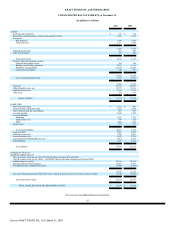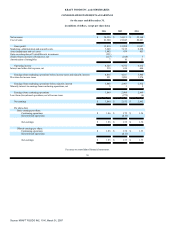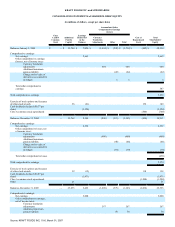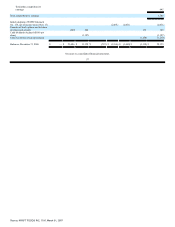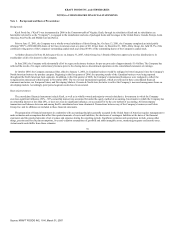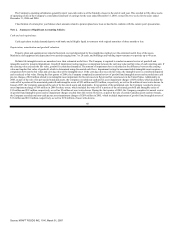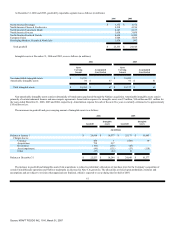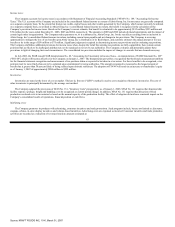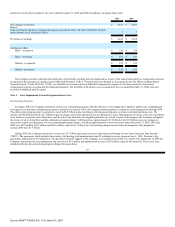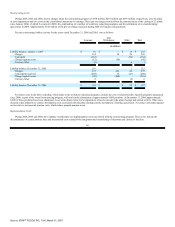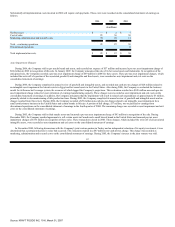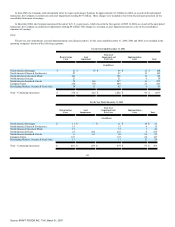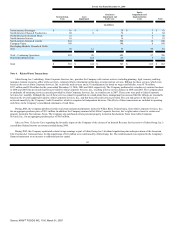Kraft 2006 Annual Report Download - page 67
Download and view the complete annual report
Please find page 67 of the 2006 Kraft annual report below. You can navigate through the pages in the report by either clicking on the pages listed below, or by using the keyword search tool below to find specific information within the annual report.
Environmental costs:
The Company is subject to laws and regulations relating to the protection of the environment. The Company provides for expenses associated with
environmental remediation obligations on an undiscounted basis when such amounts are probable and can be reasonably estimated. Such accruals are adjusted as
new information develops or circumstances change.
While it is not possible to quantify with certainty the potential impact of actions regarding environmental remediation and compliance efforts that the
Company may undertake in the future, in the opinion of management, environmental remediation and compliance costs, before taking into account any
recoveries from third parties, will not have a material adverse effect on the Company's consolidated financial position, results of operations or cash flows.
Foreign currency translation:
The Company translates the results of operations of its foreign subsidiaries using average exchange rates during each period, whereas balance sheet accounts
are translated using exchange rates at the end of each period. Currency translation adjustments are recorded as a component of shareholders' equity. Transaction
gains and losses are recorded in the consolidated statements of earnings and were not significant for any of the periods presented.
Guarantees:
The Company accounts for guarantees in accordance with Financial Accounting Standards Board ("FASB") Interpretation No. 45, "Guarantor's Accounting
and Disclosure Requirements for Guarantees, Including Indirect Guarantees of Indebtedness of Others." Interpretation No. 45 requires the disclosure of certain
guarantees and the recognition of a liability for the fair value of the obligation of qualifying guarantee activities. See Note 18.Contingencies for a further
discussion of guarantees.
Hedging instruments:
Derivative financial instruments are recorded at fair value on the consolidated balance sheets as either assets or liabilities. Changes in the fair value of
derivatives are recorded each period either in accumulated other comprehensive earnings (losses) or in earnings, depending on whether a derivative is designated
and effective as part of a hedge transaction and, if it is, the type of hedge transaction. Gains and losses on derivative instruments reported in accumulated other
comprehensive earnings (losses) are reclassified to the consolidated statement of earnings in the periods in which operating results are affected by the hedged
item. Cash flows from hedging instruments are classified in the same manner as the affected hedged item in the consolidated statements of cash flows.
Impairment of long-lived assets:
The Company reviews long-lived assets, including amortizable intangible assets, for impairment whenever events or changes in business circumstances
indicate that the carrying amount of the assets may not be fully recoverable. The Company performs undiscounted operating cash flow analyses to determine if
an impairment exists. For purposes of recognition and measurement of an impairment for assets held for use, the Company groups assets and liabilities at the
lowest level for which cash flows are separately identifiable. If an impairment is determined to exist, any related impairment loss is calculated based on fair
value. Impairment losses on assets to be disposed of, if any, are based on the estimated proceeds to be received, less costs of disposal. During 2006, the Company
recorded non-cash pre-tax asset impairment charges of $245 million related to itsTassimo hot beverage business. The charges are included in asset impairment
and exit costs in the consolidated statement of earnings.
62
Source: KRAFT FOODS INC, 10-K, March 01, 2007


